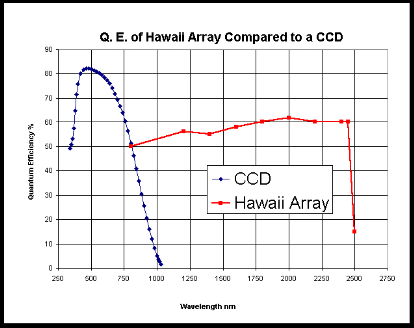| The ING Newsletter | No. 1, September 1999 |
| GENERAL | SCIENCE | OTHER NEWS FROM ING | TELESCOPE TIME |
Previous: Adaptive Optics at the WHT | Up: Table of Contents | Next: Super Cool Technology
INGRID: A New Near-IR Camera for the WHT
Chris Packham
(ING)
The new near-IR camera to be operated at the WHT is now nearing completion ready for its commissioning date, now set for January 2000. INGRID (the Isaac Newton Group Red Imaging Device) was designed and partially built by the RGO and finished at the ING during the last year.
At INGRID's heart is a 1024×1024
pixel HgCdTe array developed by Rockwell International Science Centre and
the University of Hawaii, which features good sensitivity from 0.8 to 2.5
mm. The sensitivity of the Hawaii array is very competitive compared
with that of a standard optical CCD from a wavelength of 0.8 mm as shown
in Figure 1. INGRID will typically be mounted at the folded Cassegrain
focus near-IR port of the WHT, opposite to the optical auxiliary port imaging
CCD camera, to provide a plate scale of 0.25 arcseconds per pixel to give
a field of view of 4.27×4.27 arcminutes. This will allow rapid
changes between optical to near-IR imaging facilitating colour mapping.
INGRID will also be used in conjunction with NAOMI (described by Jeremy
Allington-Smith et al. in this newsletter) as the imaging camera.
With NAOMI, the pixel scale is 0.04 arcseconds per pixel in order to exploit
the high resolution NAOMI can provide at near-IR wavelengths.
 |
| Figure 1. Quantum Efficiency of a Hawaii Array compared to that of a CCD. [ GIF ] |
Current members of the INGRID team include Gordon Talbot (project manager), Chris Packham (project scientist), Paul Jolley, Kevin Dee and Bart van Venroy (mechanical), Simon Rees & Mathieu Bec (software), Peter Moore (detector), Sue Worswick (optics) and Andrew Humphrey (librarian). The ATC and the IAC also provide valuable help as does Keith Thompson, the ex-RGO project scientist.
At the time of writing we are preparing to enter the performance and science verification stage. We envisage this stage to take around three months for precise characterisation and alignment of all elements of INGRID. Some initial verification has already been successfully achieved but many hurdles remain to be overcome. Shortly after the commissioning phase the ING will offer several nights of service time earmarked for INGRID observations to allow rapid science exploitation of the unusual capabilities INGRID can deliver. Please watch the INGRID's WWW for more information on this:
http://www.ing.iac.es/Astronomy/instruments/ingrid/
The main design criteria for INGRID is excellent optical quality ready for the integration with NAOMI. The optics are all-refractive in design and are split into two parts. The camera is placed within the cryostat to minimise thermal background, and requires an alignment accuracy of 20 mm between the four lenses. As ING will offer INGRID at two focal station, two warm collimators are available which enable a change of focal station without thermally cycling the cryostat. In order to minimise thermal background, selectable pupil stops are included which effectively undersize the secondary mirror and obscure the virtual image of the Cassegrain hole. Precise alignment of INGRID to the WHT science beam is achieved through a retractable pupil imaging mechanism that will allow alignment during the day.
A filter set is available which includes the standard Z, J, H, K and Ks broad band and 10 narrow band filters (see WWW page for details). All of these filters were purchased through the Gemini filter buying consortium and hence will provide INGRID users with data that is completely comparable to data obtained at many of the 8 m class telescopes. The filters are of excellent optical quality and are fully adaptive optics compliant for use with NAOMI.
During runs at the folded Cassegrain focus, INGRID will use a closed cycle cooler to remain cold. For rapid cool-downs and completely vibration free observations during NAOMI runs, we will use liquid nitrogen cooling. There are several read-out modes available for INGRID but all feature a full frame readout in 1.5 seconds. The typical readout mode will be double correlated sampling, but others include windowing (for high-speed observations), multiple non-destructive reads (for reduced read noise), image co-average (for reduced dead-time) and movie mode (for target acquisition). The dark current is low and as the read-noise of a double correlated sample is low (expected to be ~10e– or lower per read), most exposures will be sky noise limited. All images are automatically displayed on an IRAF display tool that also plots the seeing and sky background against time. Pixel saturation is notified to the observer via a colour change of the affected pixels as seen on the display tool.
Estimates of the throughput of INGRID suggest a similar sensitivity to that of WHIRCAM but with a much lower thermal background and a gain in sky coverage of a factor greater than 17. The limiting magnitude, based on a 9000 second on-sky observation of a stellar source in 1" seeing, is 24.3, 23.1 and 22.1 mag at J, H and Ks respectively. Observing is facilitated via the use of pre-prepared observatory and user generated UNIX scripting.
The potential science applications for INGRID are numerous, especially when integrated with NAOMI. Applications include quasar host detection, probing the centres of active galactic nuclei, brown dwarf detection, planetary nebulae, young stellar objects, crowded field photometry, etc. At the folded Cassegrain focus INGRID will be able to improve on the observations of WHIRCAM as well as providing the opportunity to observe from U to K. As INGRID will typically be mounted cold at the folded Cassegrain focus, target of opportunity observations (such as gamma ray bursts, supernova, etc.) are ideal for this instrument.
Email contact: Chris Packham (cp@ing.iac.es)
Previous: Adaptive Optics at the WHT | Up: Table of Contents | Next: Super Cool Technology
| GENERAL | SCIENCE | OTHER NEWS FROM ING | TELESCOPE TIME |